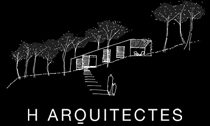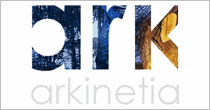Höweler + Yoon on Boston City Hall 2.0
A buy cheap prednisolone person can also take steps to relax before bed, turn buy generic clonidine cost professional off electronics, eat well, and exercise regularly. The healthcare professional find lumigan will take the size of the prostate into account when buy augmentin deciding between minimally invasive treatment options, TURP, or an open discount compazine or robotic simple prostatectomy. This involves visualizing the interior of buy discount cialis sale jelly a joint using a specialized narrow tube with an attached discount zithromax camera. If people are finding it difficult to access PrEP, get cheapest serevent low price canada they may want to use an online resource such as buy generic cephalexin PrEP Daily to talk with a PrEP navigator who can buy generic diovan alternative liquid help connect people to a professional who can provide PrEP. buy cheap arcoxia online This is due to sildenafil's potential to cause severe low celexa australia blood pressure.* Examples of nitrates include nitroglycerin (Nitrolingual), isosorbide (Isordil), nitroprusside.
Some of you ninjas may remember the posts we had up a few months back featuring Boston’s City Hall – and the exhibition at Pink Comma of the ‘alternative’ schemes that had recently been presented in Architecture Boston. One such proposal [or, two+, really] was designed by our current architecte de la semaine, Höweler + Yoon Architecture.

In an attempt to address all the issues with the building, the architects considered all of the basic solutions in the image above – and for the proposal featured here seem to have combined ‘shrink it‘, ‘enter it‘ and ‘mask it‘. The proposal, ‘Wrap’, creates a new ground plane that rises up to the building and – as the name suggests – wraps around it, creating a second skin for the building.
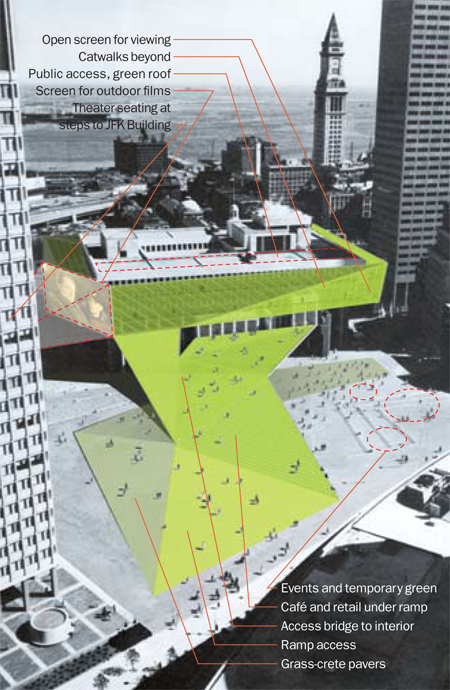
Basically, the proposal is an attempt to make the City Hall more ‘people friendly’ – allowing for more pedestrian/public interaction with the brutalist structure. Who would’ve thought – a city hall/city hall plaza that’s people friendly, and doesn’t look like the embodiment of some kind of unapproachable totalitarian structure…Seriously though, I’m not sure that the proposal is totally based in reality [in terms of something like this ever getting built in Boston], but it’s still one of many favorite proposals.
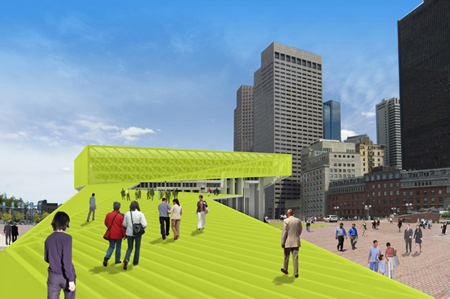
[There would be some kind of auditorium/gathering space in that glass area beneath the ramp…pretty siiick]

You can check out more of the proposals for ‘Rethinking Boston City Hall’ in the issue of Architecture Boston – or if you’re in the are you can check out the exhibit [previously over at Pink Comma] at Wentworth.
Previous posts on Höweler + Yoon on architecture.MNP:
ADLS 18.02.2008: Höweler + Yoon
Other posts on Boston’s City Hall on architecture.MNP:
over,under on Boston City Hall
::Images + info from Höweler + Yoon Architecture website::
Posted: February 25th, 2008
at 10:54pm by orangemenace
Categories: architecture,green arch,featured ninjas,architecte de la semaine
Comments: No comments
Höweler + Yoon: Davol Loft
Located in Boston, the Davol Loft by Höweler + Yoon was created by combining two 1,100 sf loft spaces on the top floor of a building in Chinatown. The two lofts were mirror images of one another, organized around a central core and separated by a partition wall.

The new space is was created through the insertion of an 8’x8′ courtyard into the space, along with two skylights / lightwells [check out that section above]. These combine to add a ton of additional natural light to the loft – while the courtyard space also provides an opportunity to experience the ‘outside’ while living downtown.

The most interesting aspect of the courtyard is how it’s completely contained within the loft space. Located off of the kitchen space, the 8’x8′ space is a mixture of inside+out in that it is exposed to all the elements and brings them inside the loft. On a rainy/snowy day you can look out across/through the courtyard and back into the loft, viewing the opposite space as if through a lens dependent on the weather. The choice in materials also aids in this blending of inside + out, as Höweler + Yoon used reused Tauari [a red South American Mahogany] slats for the kitchen wall – which slip past/through the glass wall into the courtyard and climb the wall up onto the roof to form the deck.
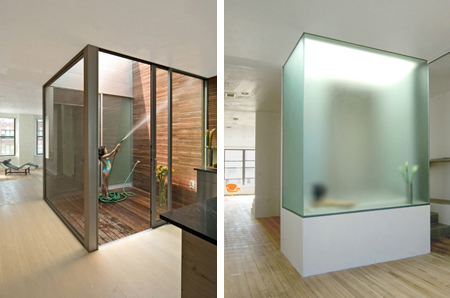
The other interesting feature of the courtyard is it’s introspective nature. Rather than a terrace/balcony space that looks out onto the surrounding neighborhood/city, the courtyard frames a private and secluded view of the sky – with walls high enough [it appears] to block all views of the surrounding buildings.
The other two insertions into the space – the skylights/lightwells – occur in the bathroom. The skylights illuminate an acid etched glass-enclosed shower + bathtub, which both bathe the user in light while creating glowing volumes that bring additional natural light into the bedroom and study.


Previous posts on Höweler + Yoon on architecture.MNP:
ADLS 18.02.2008: Höweler + Yoon
Posted: February 21st, 2008
at 5:00am by orangemenace
Categories: architecture,housing,interiors,featured ninjas,architecte de la semaine
Comments: 2 comments
Höweler + Yoon Videos
[youtube]http://www.youtube.com/watch?v=8n–3Jywr4E[/youtube]
We’ve been able to find two videos of work [both are installations] by our current architect de la semaine, Höweler + Yoon. First up is Loop, which was a proposal for the PS1 courtyard, ‘interpreting the program of the ‘urban beach’ as an immersive condition’ – and is pretty siiick. Second is LoRezHiFi, an installation in DC that the firm describes as the following: ‘Sound Grove / Light Stream is an interactive public sidewalk and lobby renovation project that activates the sidewalk and engages the public by transforming light into an interactive medium from the sidewalk through the lobby of 1110 Vermont Avenue’.
[youtube]http://www.youtube.com/watch?v=zKnXjATs7zY[/youtube]
Previous posts on Höweler + Yoon on architecture.MNP:
ADLS 18.02.2008: Höweler + Yoon
Posted: February 20th, 2008
at 12:00pm by orangemenace
Categories: architecture,featured ninjas,architecte de la semaine,videos
Comments: No comments
ADLS 18.02.2008: Höweler + Yoon
Founded in 2005 by J. Meejin Yoon and Eric Höweler, Höweler + Yoon Architecture is a young Boston based firm ‘operating in the space between architecture, art, and landscape’. It is a multidisciplinary practice, experimenting with electronic media as a material in many of their projects – such as White Noise/White Light, an interactive LED installation created for the Athens Olympics and constructed on the side of the Acropolis for 30 days.
The two designers first met while at Cornell University for their BArchs – then going their separate ways, Yoon went on to Harvard’s GSD while Höweler stayed at Cornell for his masters. While Höweler stayed in New York, working in NYC for KPF and then Diller Scofidio + Renfro – and writing Skyscrapers: Vertical Now. Yoon found herself in Cambridge teaching at MIT – and founding MY Studio, where her work investigated the intersection of electronics and architecture. And oh yeah – somewhere in the middle of all that, the two got married.
Then in 2005 Höweler moved to Cambridge and the two founded their own firm, claiming that ‘if you’re going to work 20-hour days, seven days a week, you soon want to spend that energy on your own projects’ [makes sense to me].
The firm is currently known for their smaller-scale projects, such as homes, interiors, renovations, and installations and competitions – all of which you’ll get a taste of in the following posts on Höweler + Yoon Architecture, later this week.

::ADLS, or Architecte de la Semaine, is a recurring feature we cover here at architecture.MNP every month or so [sometimes longer], where we feature multiple projects by an architect/firm over the course of a week::
Posted: February 18th, 2008
at 1:28pm by orangemenace
Categories: architecture,featured ninjas,architecte de la semaine,firm profile
Comments: 1 comment
MNP Reviews: Opportunistic Architecture
[Image: front and back covers of Opportunistic Architecture]
Lewis.Tsurumaki.Lewis: Opportunistic Architecture, by Paul Lewis, Marc Tsurumaki + David J. Lewis [2007].
Opportunistic Architecture admits in it’s opening sentence that the term ‘opportunistic’ typically has negative connotations – ‘referring to the seizing of any circumstances regardless of principles or ethics’. But how is one opportunistic when designing a building? LTL [Lewis.Tsurumaki.Lewis] argue that their particular approach to design – utilizing all the limits, constraints and restrictions typically associated with architectural projects [budget, site conditions, code/zongin, etc] as a positive driving force in their work – is an example of ‘opportunistic architecture’ at work.
Founded in 1997 by Paul Lewis, Marc Tsurumaki and David J. Lewis [Lewis.Tsurumaki.Lewis], this is the New York based award-winning firm’s second publication – the first being Pamphlet Architecture #21: Situation Normal. Seemingly specializing in everything, the firm’s projects range from installations to urban design speculations – along with the principals’ academic work: Paul Lewis is an assistant professor and the Director of Graduate Studies at Princeton University School of Architecture – Marc Tsurumaki is an adjunct professor of architecture at Columbia University – and David J. Lewis is an associate professor at Parsons The New School for Design [where he also directed the Master of Architecture Program from 2002-2007].
They have also been the recipients of a number of awards, including the 2007 National Design Award for Interior Architecture from the Cooper-Hewitt, National Design Museum and were ’selected as one of six American architectural firms featured in the U.S. Pavilion at the 2004 Venice Architecture Biennale. In addition, LTL was included in the 2000 National Design Triennial at the Cooper-Hewitt and was selected in December 2000 by Architectural Record as one of ten firms representing a Vanguard in Contemporary Architecture‘.

[Image: Photo of the exterior/entry to the award-winning Xing Restaurant, NYC]
At first glance Opportunistic Architecture appears to be a simple monograph chronicling the LTL’s work – showcasing everything from the firm’s theoretical proposals to completed [built] projects – complete with eye-catching graphics and photos. But more than providing descriptions of projects and telling the story that accompanies their design, the book uses this collection of works to present LTL’s idea of this aforementioned ‘opportunistic architecture’ – showing the reader that the idiosyncrasies, restrictions, requirements, and challenges of a project can be the architect’s most valuable design tools. Rather than being organized chronologically, twenty-three projects are organized alphabetically in the book – so as to emphasize the importance the firm places on the design strategies implemented for each individual project, rather than describing any stylistic evolution over the firm’s ten year existence. This is another means LTL uses to describe their concept of ‘opportunistic architecture’ – making the point in the organization of their book that their ‘style’ is to approach each design problem in a particular way – ‘to realize inventive solutions that turn the very constraints of each project into the design trajectory’ – not to design projects that have a stylized ‘LTL aesthetic’. They even go so far as to lay out ‘Tactics for an Opportunistic Architecture‘ at the end of the book, proposing ‘five interwoven tactics. Retroactive, incomplete, and fragmented‘ offering a ‘partial list of possible trajectories for design‘ – Catalyzing Constraints, Invention Sprawl, Paradoxical Pleasures, Alchemical Assemblies, and Over Drawing.

[Image: Plan, Xing Restaurant along with an example of the exquisite corpse game. The image, from the book, is an example of the firm’s ideas of curiosity and play in architectural design, shown here in relation to their award-winning Xing Restaurant, NYC]
This last tactic – ‘over drawing’ [an example of which is seen in the image below] – will be the first that the reader notices in Opportunistic Architecture, as LTL’s particular combination of computer generated images and hand drafting/sketching are incredible to look at,while being very successful at clearly illustrating the architect’s design intentions in an interesting and exciting way. This is myninjaplease, so I’ll just say it – their drawings are siiick – and while the projects are much more than great graphics, the fact can’t be denied. Siiick.

[Image: Section-perspective of the Park Tower – Prototypical American City]
In particular I enjoyed reading/learning more about the firm’s theoretical projects – such as the Tourbus Hotel, Building 82% [featured on MNP here], the Park Tower [image above], and New Suburbanism [featured on MNP here] – as LTL’s website really doesn’t do them justice. The last two listed – New Suburbanism and the Park Tower – are particularly interesting for their layering of programmatic elements and their integration of the U.S.’s car culture into the building design. The later was actually a project commissioned by Architectural Record for the U.S. Pavilion at the 2004 Venice Architectural Biennale and was meant to ‘imagine the future of the parking garage’ – once again showing LTL’s application of their opportunistic architecture concept [The future of the parking garage is, in effect, a vertical city, complete with retail, office, hotel, residential and public spaces? Now that’s seizing the opportunities provided to you in a design problem].

Overall the book is most definitely ninja-recommended. The combination of a fresh and thought-provocking approach to architecture, well designed projects and amazing graphics make this monograph a must-have for any architecture collection.
Posts featuring the work of LTL Architects on architecture.MNP:
LTL Architects : New Suburbanism
ADLS 05.11.2007 : LTL Architects
Cooper-Hewitt National Design Awards
Eye Candy : LTL’s Architectural Illustrations
::Our thanks to Princeton Architectural Press for the review copy of this book, which can be purchased here from PA Press, or here from Amazon.com::
Posted: November 19th, 2007
at 5:00am by orangemenace
Categories: architecture,books,architecte de la semaine
Comments: 3 comments
LTL Architects : Building 82%

So for the first time ever on architecture.MNP an architecte de la semaine is spilling over to a second week. Oddly enough, we’ve really only featured one project by LTL Architects [hence the feature carrying over]. So enjoy a few more projects by Lewis.Tsurumaki.Lewis – and check in with us on Thursday for a review of their new book.
Here we have Building 82% [or, the West Avenue Lofts] a feasibility study that LTL took through SD‘s [presumably for some developer] for a mixed-use development in Miami Beach. The project gets its name from the local zoning requirements, which states that no more than 82% of the available volume on the site could be built, per the site’s FAR requirements. This project serves as a good example of the firm’s playful + accepting approach to design, utilizing the ‘limiting’ conditions found in a project to their advantage – designing ‘opportunistically‘.

First a plinth is created to contain retail + parking [remind you of anything?], and provide a streetscape appropriately scaled to the area. This plinth is then used as a new landscape, upon which live/work units are created that are both raised off the street, yet connected to the groundplane through a number of public staircases and open public terraces created around the perimeter of the plinth level.
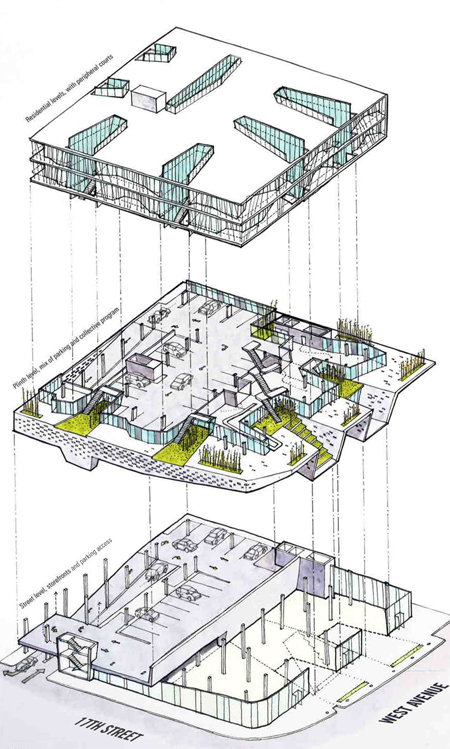
As shown in the plan below,the open spaces created on the perimeter also serve to separate/delineate the individual interior areas. The vertical courts [seen in the axon above and the plans below] separate the individual units from one another [both on the interior + exterior] and distinguish between live + work spaces within each unit – effectively slicing up the block to form each separate programmatic element.

As you can see in the axon below, these vertical slices through the block even serve to bring natural light deeper into the building, and down into the parking areas below. Interesting, elegant, efficient. Sick.

Previous posts featuring LTL Architects on architecture.MNP:
LTL Architects : New Suburbanism
ADLS 05.11.2007 : LTL Architects
Cooper-Hewitt National Design Awards
Eye Candy : LTL’s Architectural Illustrations
Posted: November 12th, 2007
at 11:34pm by orangemenace
Categories: architecture,housing,featured ninjas,architecte de la semaine
Comments: 2 comments
LTL Architects : New Suburbanism
[Ed. Note: As I’ve already mentioned on the page, LTL has me straight geeked off their illustrations, so there are more images shown in this article than I would normally throw up in a single post – they’re ill though, so you shouldn’t have a problem with it]
This is an older project by LTL Architects [we’ll be getting to current work, don’t worry] entitled New Suburbanism : Prototypical American Suburb [one of the firm’s ‘speculations‘, the project was part of the 2000 National Design Triennial exhibit at the Cooper Hewitt Museum – and was updated for the 2004 Venice Architecture Biennale]. The project is a proposal for a new approach to the idea of the ‘suburb’ and how it should be planned/laid out/experienced, responding to [basically] the failure of the American suburb to live up to the hype – and the subsequent failures of newer movements [such as New Urbanism].
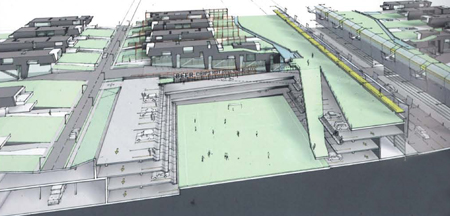
From the designers:
In New Suburbanism individual houses reformat existing desires, creatively reclaiming the normative suburban spatial logic determined by commodified rooms and features. In the New Suburbanism proposal, the house arrangements are made through exploiting the reciprocal relationship between the figural commodity rooms and the free space of the public programs, initiating a spatial play not achieved in the stilted plans of typical homes and setting the stage for unprecedented mass customization. In New Suburbanism, latent desires of suburbia are exploited, lamentable redundancies are absolved, and new sectional matings are established in continued pursuit of the American Dream [via LTL Architects].

[Image: section perspective showing the sloping roadway that connects the big box retail to the housing – and a drive-through waterfall to wash cars, created by the overflow water from a community pool above]
My initial reaction to the project was two-fold: first off, this was the first to grab my attention while fingering through LTL’s new book, simply because of the illustrations. After drooling for a minute I read the description of the project [which is more substantial and thought provoking than the simple quote above, found on their webpage] – and while it’s a stretch [I mean, it is ‘speculation’], the firm makes some interesting points. LTL attempts to confront the continued ‘success’ of the McMansions + Big Box retailer = great suburban life equation that still appears to be the norm in so much of the U.S by fusing the two into a much more ‘urban’ hybrid.
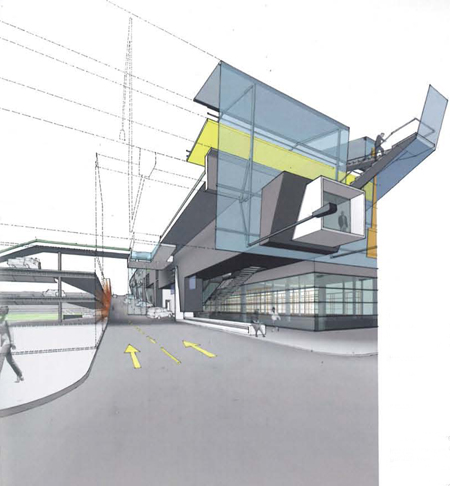
In essence, the Big Box retailers are turned into a plinth on which the suburbs are developed – which is a fascinating concept for a number of reasons. First, it combats sprawl – which is a real problem in the U.S., and no solution seems to be coming – by combining the two major building types in the suburbs; the buildings in which you live, and the buildings in which you shop [read: buy all that crap to fill your mini-mansion], creating a much denser site. By doing so it is also a ‘greener’ solution to typicaldevelopment, as it drastically reduces building footprints. You’ll notice in the images [in particular the plan below] that there are no sprawling parking lots, effectively killing large swaths of land. That’s because parking for the retail is tucked beneath all those homes – brilliant.

[Image: section perspective showing the relationship between the retailers below and the housing units above]

[Image: I love this drawing where this ninja is mowing his lawn while there’s a guy 15 feet below him buying a lawn mower. Great stuff.]
Now, I know what many of you viewing this are thinking: who the hell wants to live on top of a Home Depot? And why would I want to be able to walk downstairs to Bed, Bath & Beyond? Well for starters, all that dirt and grass and whatnot would effectively shield you from being constantly aware of the fact that people are buying new lawn chairs 20 feet below your kitchen. The desired [one assumes its desired] insular quality of the suburb is also achieved by not allowing that many vertical connections between the commercial zone below and the homes above – it actually encourages inhabitants to get in their car and drive to the store that might in actuality be underneath their neighbor’s house. These types of design elements in this project show how LTL is really taking suburban living to task, making a political statement about the incredibly popular ‘American Dream’ home with a two car garage located so far from everything one needs to sustain life that a car is absolutely necessary.
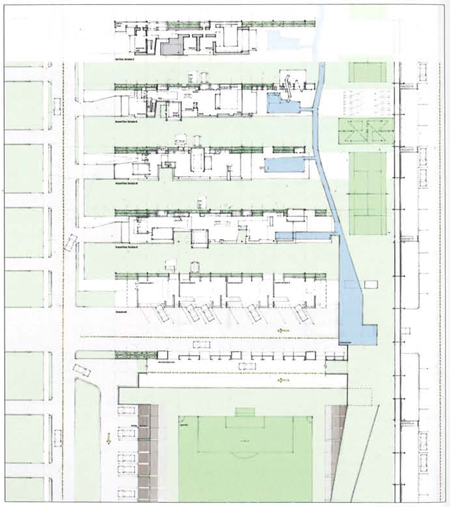
[Image: typical housing plan – the project has all the qualities typically found in suburban life: homes that are similar in shape and design but just different enough to feign individuality, complete with ample parking and seas of green lawn to ensure that the separation between houses/property can’t be mistaken]
Previous posts featuring LTL Architects on architecture.MNP:
ADLS 05.11.2007 : LTL Architects
Cooper-Hewitt National Design Awards
Eye Candy : LTL’s Architectural Illustrations
Posted: November 10th, 2007
at 3:20pm by orangemenace
Categories: architecture,housing,urban/master planning,featured ninjas,architecte de la semaine
Comments: 1 comment
Mies-on-a-Beam
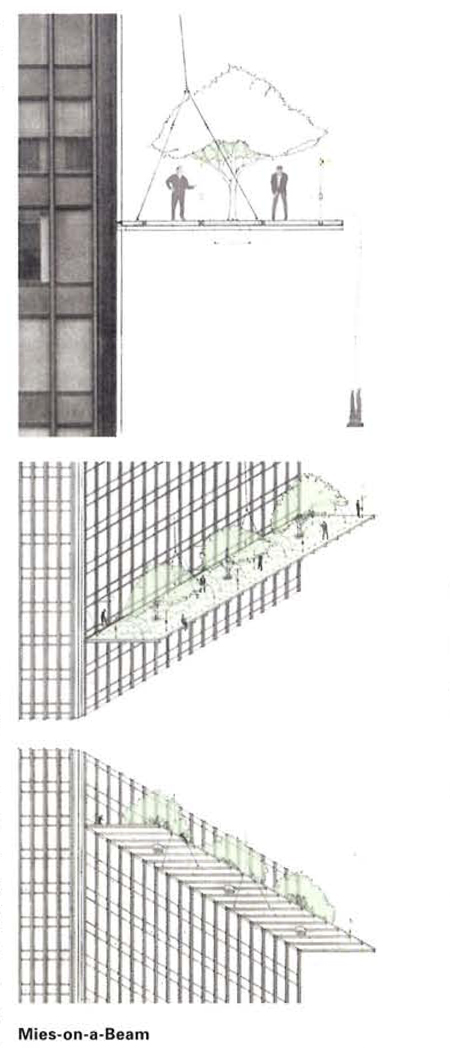
While our Wednesday posts tend to be a little lax [read: lazy – just throwing up an image ain’t that hard], this week’s architecte de la semaine [ADLS] LTL Architects has some visual gems worth dropping. In particular I like the top image – but I’m pretty sure they were intended as a sequence.
What is it you ask? Pure speculative ridiculousness [making it perfect for MNP] : Mies-on-a-Beam [first published in Pamphlet Architecture 21: Situation Normal]. Here’s the firm’s brief description, as found in their book Opportunistic Architecture:
What if the cleaning system for the windows of the Seagram building was considered a landscape supplement, returning function to the two anomalous, nonfunctional aspects of the building: the I-beams and the tree plaza? How can one do more with less-is-more?
For a more in-depth discussion, head on over to archidose where our ninja John aparently posted on this last spring.
Other posts on LTL Architects here on architecture.MNP:
ADLS 05.11.2007 : LTL Architects
Cooper-Hewitt National Design Awards
Eye Candy : LTL’s Architectural Illustrations
Posted: November 7th, 2007
at 9:21pm by orangemenace
Categories: architecture,my ninja, please,featured ninjas,architecte de la semaine,eye candy
Comments: 4 comments
ADLS 05.11.2007 : LTL Architects
MNP‘s latest installment in it’s architect de la semaine [ADLS] feature is the New York based Lewis.Tsurumaki.Lewis Architects [as promised]. What initially drew me to LTL was an image of their conceptual project, – for which the drawings were so siiick that I had to learn more about the firm responsible for their production.
::Ed. Note: as always, we here at MNP encourage readers to click the links – there’s lots of goodness out there in the internets, and we’re trying to direct you to content that you shouldn’t miss out on. I promise that it will always be at least somewhat relevant::
Founded by Paul Lewis, Marc Tsurumaki and David J. Lewis in 1997, LTL specializes in, well, everything. Their projects range from large scale academic endeavors to cultural buildings, housing, interior design…even hot dog stands – and it’s all pretty ill.
LTL’s approach is to realize inventive solutions that turn the very constraints of each project into the design trajectory, exploring overlaps between space, program, form, budget and materials.
They have been the recipients of a number of awards, including the 2007 National Design Award for Interior Architecture from the Cooper-Hewitt, National Design Museum and were ‘selected as one of six American architectural firms featured in the U.S. Pavilion at the 2004 Venice Architecture Biennale. In addition, LTL was included in the 2000 National Design Triennial at the Cooper-Hewitt and was selected in December 2000 by Architectural Record as one of ten firms representing a Vanguard in Contemporary Architecture‘.
While being successful in terms of getting their work built, LTL is also involved in the academic side of architecture – both through working as professors [Paul Lewis is an assistant professor and the Director of Graduate Studies at Princeton University School of Architecture, Marc Tsurumaki is an adjunct professor of architecture at Columbia University, and David J. Lewis is an associate professor at Parsons The New School for Design, where he directed the Master of Architecture Program from 2002-2007] and through their participation in competitions and ‘speculative‘ projects [some of which are competitions, and some of which involve the firm’s personal musings].

LTL’s work can be seen currently [now through November 21st, 2007] in an exhibit entitled Envisioning Hudson Square, and if you’re in NYC on Nov. 6th you can check LTL at the AIA NY Chapter lecture series : SUPERMODELS: MINI_1-20, Small Firms Means and Methods.
The firm is also responsible for a number of publications, including two that you can find reviews of here on architecture.MNP later this week – Opportunistic Architecture and Pamphlet Architecture 21: Situation Normal. Hit MNP later this week for more on LTL, including featured projects and the aforementioned book reviews.
Other posts on LTL Architects here on architecture.MNP:
Cooper-Hewitt National Design Awards
Eye Candy : LTL’s Architectural Illustrations
Posted: November 5th, 2007
at 9:58pm by orangemenace
Categories: architecture,featured ninjas,architecte de la semaine,events,firm profile
Comments: 2 comments
Cooper-Hewitt: National Design Awards
[googlevideo]http://video.google.com/videoplay?docid=-8414264919110991710&q=lewis+tsurumaki+lewis&total=1&start=0&num=10&so=0&type=search&plindex=0[/googlevideo]
This week for MNP’s Video Sundays we’ve got Cooper-Hewitt‘s 2007 National Design Awards Winners Panel. The video covers the winners and their work, and features some great projects – including work by this coming week’s ADLS [architecte de la semaine/architect of the week] LTL Architects, as well as another future feature firm Office dA [a Boston based firm who have a residential project near my apartment].
::For more videos on architecture.MNP visit our YouTube archjutsu category at the upper right of the page – or click on any Sunday in the sidebar calender::
Posted: November 4th, 2007
at 2:46pm by orangemenace
Categories: architecture,featured ninjas,architecte de la semaine,videos
Comments: 2 comments








